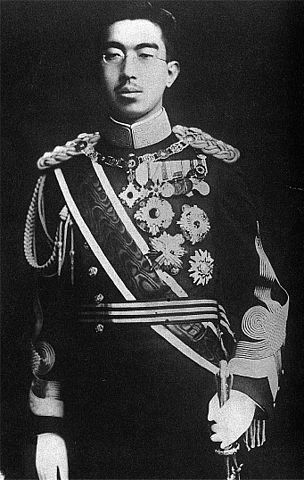HIROHITO (EMPEROR SHŌWA) (1901–1989)

Hirohito is better known outside Japan by his personal name, Hirohito, which means “abundant benevolence.” Among the Japanese he is now primarily known by his posthumous name, Emperor Shōwa or Shōwa Emperor, the name of the era (“Enlightened Peace”) that corresponded with his reign. He reigned as the 124th Emperor of Japan, from December 25, 1926, until his death 87 years later in 1989. As emperor and head of state under the limitations imposed by the Imperial Constitution, Hirohito was eyewitness to Japan’s imperial expansion, militarization, involvement in World War II, and postwar resurrection.
Hirohito’s tenure on the Imperial throne took place against the backdrop of increasing military power within the government. Since 1900 the Imperial Japanese Army and Imperial Japanese Navy held veto power over the formation of Japanese cabinets, and in 1932 civilian control of the military all but ended. The year before, 1931, the Japanese military invaded Manchuria, and that was followed by war with China (Second Sino-Japanese War) in 1937. Hirohito personally ratified the proposal by the Japanese Army to remove the constraints of international law on the treatment of Chinese prisoners of war on August 5, 1937, and authorized the use of chemical weapons against Chinese soldiers and civilians in 1938, again in the face of international (League of Nations) condemnation. In September 1940, Hirohito consented to his government’s entry into the Tripartite Pact with Adolf Hitler’s Germany and Benito Mussolini’s Italy.
On September 5, 1940, Prime Minister Prince Fumimaro Konoe informally submitted to Hirohito a draft of a decision taken the day before by the Japanese Cabinet, a plan devised by the Imperial General Headquarters. The decision was to be formally implemented the next day, September 6, at the Imperial Conference. The plan proposed that for purposes of “self-defense” and “self-preservation” Japan was resolved to go to war if necessary with the United States, Great Britain, and France (now vanquished by Hitler) in order to continue its conquest of China and Southeast Asia. The plan also demanded that neither the U.S. nor Great Britain increase their military forces in the Asia-Pacific region, and that the West assist Japan in acquiring goods “needed by our Empire”—a reference to the Western powers lifting economic and monetary sanctions imposed on Japan due to that nation’s continuing war in China. On November 2, after a review of the war plans led by Konoe’s hard-line successor, Gen. Hideki Tōjō, Hirohito gave his consent to going to war with the West (the U.S., Great Britain, and the Netherlands) and reviewed the navy’s plan to bomb Pearl Harbor. On December 1, an Imperial Conference sanctioned the war.
As the tide of war shifted in favor of the Western allies, Hirohito exhorted his military to greater efforts. But when exhortation failed to deliver the desired efforts, Hirohito encouraged both service members and civilians to commit suicide rather than be taken prisoner. Over 10,000 civilians committed suicide in the last days of the battle to take the Japanese-held island of Saipan (July 1944). In June 1945, when the military situation had turned hopeless, Hirohito and the cabinet agreed to approach the Soviet Union to act as a mediator for a negotiated surrender. However, the July 26, 1945, Potsdam Declaration by the U.S, Great Britain, and China gave Japan only two choices: unconditional surrender or utter destruction. Japan’s initial rejection of the demand led to the incineration of two Japanese cities (August 6 and 9, 1945) and Japan’s unconditional surrender (September 2, 1945). However, the Japanese were able to secure assurances regarding the safety and position of Hirohito on the throne prior to surrendering, subject to the discretion of the Supreme Commander for the Allied Powers, Gen. Douglas MacArthur.
Actually, MacArthur and his staff had their hands tied. Just days earlier, on August 29, 1945, the supreme commander was ordered to exercise occupation authority through the machinery of the Japanese government, including Emperor Hirohito. That said, MacArthur and his staff forced Hirohito to reject his claim to being an incarnate divinity, stripped him of his military authority, drafted a new constitution that renounced war, instituted a democratic parliamentary system of government, and eventually exempted Hirohito and all members of the imperial family implicated in war crimes from prosecution during the postwar Tokyo War Crimes Tribunal (1946–1948). For the rest of his life, Emperor Hirohito was an active figure in Japanese life and performed many of the duties commonly associated with a constitutional head of state.
![]()
History’s Verdict: Japanese Emperor Hirohito
![]()

 History buffs, there is good news! The Daily Chronicles of World War II is now available as an ebook for $4.99 on Amazon.com. Containing a year’s worth of dated entries from this website, the ebook brings the story of this tumultuous era to life in a compelling, authoritative, and succinct manner. Featuring inventive navigation aids, the ebook enables readers to instantly move forward or backward by month and date to different dated entries. Simple and elegant! Click
History buffs, there is good news! The Daily Chronicles of World War II is now available as an ebook for $4.99 on Amazon.com. Containing a year’s worth of dated entries from this website, the ebook brings the story of this tumultuous era to life in a compelling, authoritative, and succinct manner. Featuring inventive navigation aids, the ebook enables readers to instantly move forward or backward by month and date to different dated entries. Simple and elegant! Click 











